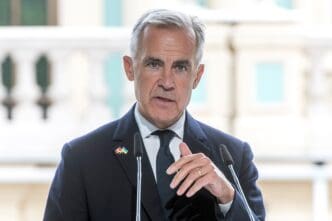Executive Summary
The Story So Far
Why This Matters
Who Thinks What?
Canada’s Prime Minister Mark Carney commenced his inaugural official visit to Asia on Friday, October 24, 2025, signaling a strategic pivot to deepen trade and security ties and reduce the nation’s considerable economic reliance on the United States. The week-long diplomatic push comes as President Donald Trump abruptly halted trade discussions with Canada, underscoring Ottawa’s imperative to forge new international partnerships.
Government officials have indicated that a meeting with Chinese President Xi Jinping may be part of Carney’s itinerary, representing a potential effort to reset a relationship strained by past disputes and ongoing trade tensions. This visit aims to project Canada’s distinct foreign policy agenda to Asian leaders, emphasizing its commitment to rules-based trade and globalization amidst a fragmenting world economy.
Diversifying Trade and Foreign Policy
Carney’s trip is a cornerstone of Canada’s broader strategy to diversify its export markets over the next decade. Currently, approximately 75% of Canadian goods are exported to the United States, highlighting the substantial challenge of this reorientation.
The Prime Minister is scheduled to attend the Association of Southeast Asian Nations (ASEAN) summit in Kuala Lumpur and the Asia-Pacific Economic Cooperation (APEC) summit in South Korea, alongside bilateral meetings in Singapore. These engagements are crucial for establishing Canada’s independent economic footing in the region.
U.S. Relations and Geopolitical Context
The urgency of Canada’s diversification efforts was amplified by President Trump’s decision on Thursday to terminate trade talks via a social media post. This action reportedly stemmed from an Ontario political advertisement featuring former President Ronald Reagan, which criticized tariffs.
Analysts, including Vina Nadjibulla of the Asia Pacific Foundation of Canada, stress that Carney must convey to Asian leaders that Canada operates with its own agenda, distinct from the U.S., whose president has previously made annexation threats. The geopolitical landscape is further complicated by President Trump’s own concurrent trip to Malaysia and a planned meeting with President Xi in South Korea next Thursday.
Targeting New Markets
Canada has already made headway in its trade diversification, having signed an agreement with Indonesia last month to establish duty-free access for up to 95% of its goods within the next year. Trade Minister Maninder Sidhu confirmed that Canada is now actively pursuing similar agreements with the Philippines, Malaysia, South Korea, and Japan.
Fen Hampson, an international affairs professor at Carleton University, noted that Asia presents more dynamic business opportunities for Canada than Europe, which Carney has visited three times since becoming Prime Minister in March. Hampson highlighted the compatibility of Southeast Asian economies with Canada’s energy and commodities trade sectors.
Navigating Canada-China Relations
The prospect of a meeting between Prime Minister Carney and President Xi Jinping comes with significant historical and geopolitical baggage. Relations between the two nations deteriorated under Carney’s predecessor, Justin Trudeau, marked by the detention and execution of Canadian citizens in China, allegations of Chinese interference in federal elections, and a public scolding of Trudeau by President Xi.
Despite these challenges, analysts suggest that Carney’s background as a former central banker and his international experience lend him credibility in attempting a reset. Carney engaged with Chinese Premier Li Qiang last month, expressing anticipation for discussions with senior Chinese leadership to explore the evolution of the trade relationship.
Public Opinion and Diplomatic Optics
Domestically, a recent poll by Angus Reid and the Asia Pacific Foundation of Canada revealed that 59% of Canadians hold a negative view of China, with only 14% advocating for closer economic ties. This public sentiment adds a layer of complexity to any rapprochement efforts.
Furthermore, experts like Isaac Stone Fish, CEO of Strategy Risks, emphasize the importance of diplomatic optics in a region that values protocol. Stone Fish cautioned that Carney’s comportment with President Xi will be closely scrutinized, as any perceived deference could be viewed as weakness.
The broader geopolitical dynamic between the U.S. and China will also inevitably influence Canada’s ability to maneuver. Hampson suggested that resolving Canada’s tariff disputes with China, such as those concerning canola and electric vehicles, will likely require improved relations between the two global superpowers, given the significant U.S. pressure on Canada not to concede to its perceived rival.
Key Takeaways
Prime Minister Carney’s Asian tour represents a critical juncture for Canada’s foreign policy and economic future. The nation is actively seeking to diversify its trade partnerships and assert a more independent global role, particularly in light of recent tensions with the United States. While the path to deeper engagement with Asia, especially China, is fraught with historical and geopolitical complexities, the economic imperative for new markets remains a driving force for Ottawa.








